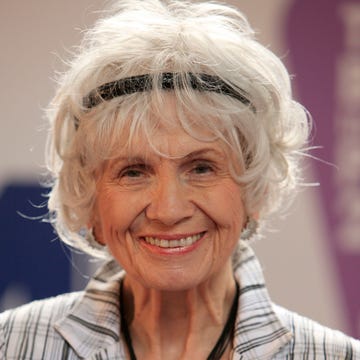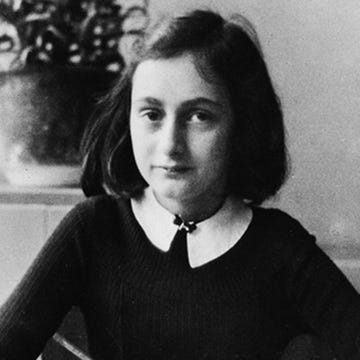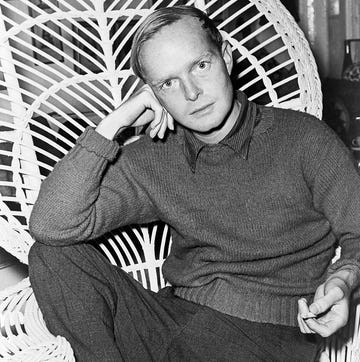(1935-2001)
Who Was Ken Kesey?
Ken Kesey attended Stanford University and later served as an experimental subject and aide in a hospital, an experience that led to his 1962 novel One Flew Over the Cuckoo's Nest. That book was followed by Sometimes a Great Notion and several works of nonfiction that detailed Kesey's transformation from novelist to guru of the hippie generation.
Early Life
Ken Elton Kesey was born on September 17, 1935, in La Junta, Colorado. He was raised by his dairy farmer parents in rugged Springfield, Oregon, where he grew to be a star wrestler and football player. At the University of Oregon, he also developed an interest in theater but was awarded a Fred Lowe Scholarship for his accomplishments in wrestling. Kesey married his high school girlfriend Norma Faye Haxby in 1956, and after briefly considering a career as an actor, relocated to Palo Alto, California, when he won a scholarship to the graduate program in writing at Stanford University.
'One Flew Over the Cuckoo's Nest'
While attending Stanford, in 1960 Kesey volunteered as a paid experimental subject in a study conducted by the U.S. Army in which he was given mind-altering drugs and asked to report on their effects. He also worked as an attendant in a hospital's psychiatric ward. These experiences served as the basis for his 1962 novel, One Flew Over the Cuckoo's Nest, which examined the abuses of the system against the individual. In 1975 the book was made into a film directed by Miloš Forman and starring Jack Nicholson. Kesey famously hated the script and refused to watch the film, but many other people didn't. After receiving much critical acclaim, it would go on to take all five of the major Academy Awards — for best picture, director, screenplay, actor and actress.
'Sometimes a Great Notion'
By the time Kesey began work on his next novel, he believed the key to individual liberation was psychedelic drugs, and he often wrote under the influence of LSD. Like Cuckoo, the resulting work, Sometimes a Great Notion (published in 1964) focused on questions of individuality and conformity. Considered among Kesey's finest works, it too would later be adapted into a film directed by and starring Paul Newman with Henry Fonda.
The Merry Pranksters
To help publicize the release of Sometimes a Great Notion, and spread his more unconventional views on liberation, Kesey gathered together a like-minded group of individuals who called themselves the Merry Pranksters. In 1964 they set out together on a cross-country trip in an old bus they dubbed Further. Covered in kaleidoscopic graffiti and captained by Neal Cassady — who was immortalized in Jack Kerouac's On the Road as Dean Moriarty — the vessel took the LSD-soaked Pranksters to the World's Fair in New York City before returning to Kesey's ranch in La Honda, California. There, the Pranksters conducted "Acid Tests," wherein attendees would receive a cup of "electric," LSD-laced Kool-Aid and resist the urge to "freak out." Guests at these events were sometimes treated to the music of a band called the Warlocks, who would later become known as the Grateful Dead.
In 1966, however, Kesey's exploits were temporarily interrupted when he was charged with marijuana possession, faked a suicide note and fled to Mexico to avoid incarceration. However, he returned to the United States the following year and served a six-month sentence on a work farm before resuming his prior activities.
Writer Tom Wolfe chronicled the Pranksters culture, and in 1968 he published The Electric Kool-Aid Acid Test, which depicted Kesey's adventures throughout the 1960s. Credited with launching the hippie counterculture movement, Kesey and the Merry Pranksters were also the focus of the 2011 documentary Magic Trip: Ken Kesey's Search for a Kool Place. The Smithsonian would later make an unsuccessful attempt to acquire their bus for its collection.
Later Life and Death
After his release from jail, Kesey settled down with his wife and their four children on his father's Oregon farm. He continued to publish short stories and essays and taught a graduate course at the University of Oregon, where he collaborated with students under the pen name O.U. Levon on the novel Caverns. He also coached wrestling at local schools and published the children's book Little Tricker the Squirrel Meets Big Double the Bear (1988).
In 1992, Kesey published his first novel in almost 30 years, a comedy titled Sailor Song. Two years later he published what would be his last novel, the Western-themed Last Go Round. Kesey died in Eugene, Oregon, on November 10, 2001, from complications after liver cancer surgery. He was 66 years old.
QUICK FACTS
- Name: Ken Kesey
- Birth Year: 1935
- Birth date: September 17, 1935
- Birth State: Colorado
- Birth City: La Junta
- Birth Country: United States
- Gender: Male
- Best Known For: Novelist Ken Kesey wrote 'One Flew Over the Cuckoo's Nest' and is credited with helping to usher in the era of psychedelic drugs in the 1960s.
- Industries
- Fiction and Poetry
- Journalism and Nonfiction
- Astrological Sign: Virgo
- Schools
- Stanford University
- University of Oregon
- Interesting Facts
- Though best know for his literary work and psychedelic exploits, Ken Kesey was an accomplished wrestler during his youth.
- Death Year: 2001
- Death date: November 10, 2001
- Death State: Oregon
- Death City: Eugene
- Death Country: United States
Fact Check
We strive for accuracy and fairness.If you see something that doesn't look right,contact us!
CITATION INFORMATION
- Article Title: Ken Kesey Biography
- Author: Biography.com Editors
- Website Name: The Biography.com website
- Url: https://www.biography.com/authors-writers/ken-kesey
- Access Date:
- Publisher: A&E; Television Networks
- Last Updated: August 5, 2020
- Original Published Date: April 2, 2014













